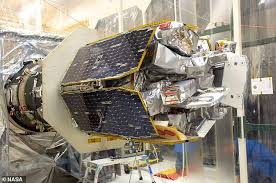Symbol will contemplate the connection between space climate and Earth climate.
CAPE CANAVERAL, Fla. — A hotly anticipated NASA crucial to test Earth’s upper environment has at long last taken off following quite a while of postponements.
The Ionospheric Connection Explorer (ICON) rocket propelled today (Oct. 10) at 10:00 p.m. EDT (0200 GMT on Oct. 11) on board a Northrop Grumman Pegasus XL rocket, which was discharged in midair from its bearer plane, a Stargazer L-1011. The flying machine had taken off about 90 minutes sooner from Cape Canaveral Air Force Station here.
Symbol will advance toward Earth circle set for concentrate the planet’s ionosphere, a gigantic layer of our climate that covers with the limit of room. The shuttle’s estimations will enable researchers to all the more likely comprehend the connection between space climate and earthbound climate, and how the two collaborate in the ionosphere, strategic individuals said.
“The ionosphere is continually changing, and it’s very dynamic,” Nicky Fox, head of NASA’s heliophysics division, explained during a prelaunch news briefing on Tuesday (Oct. 8).
“The ionosphere is a remarkable physics lab,” Fox said. “It’s not only a great place to go and study plasma physics, but it’s also a region that has a big space weather impact on us.”
Researchers have for some time been enthusiastic for the candy machine size satellite to get off the ground to perceive what it may enlighten us regarding this baffling area. As per Fox, the ionosphere gets its name because of radiation from the sun, which assaults the iotas and particles in this piece of the air, basically giving them a charge — a procedure called ionization.
It’s here where odd and exceptional marvels, for example, the auroras and geomagnetic storms, are made. It’s difficult to figure when these kinds of occasions will happen, in light of the fact that the ionosphere is an unbelievably troublesome district to examine.
Until about 10 years prior, researchers thought the sun caused the majority of the adjustments in the ionosphere, yet later research recommends that isn’t the situation; day by day changes in the locale are watched in any event, when the sun isn’t creating incredible tempests. Fox clarified this is on the grounds that earthbound climate examples and extraordinary occasions, for example, sea tempests likewise cause changes in the ionosphere.
This dynamic locale where Earth climate meets space climate is home to the International Space Station and is a basic pathway for correspondences satellites. Radio waves and Global Positioning System (GPS) signals go straightforwardly through this fierce layer, and those sign can be twisted by patches of ionized material.
This is an issue since space climate can affect interchanges frameworks as well as hardware and even power matrices. To alleviate these impacts, researchers are planning to all the more likely comprehend the sun and its numerous procedures. What’s more, ICON can help with that, crucial individuals said.

The $252 million test is going directly into the thick of the ionosphere, heading for a roundabout circle 357 miles (575 kilometers) over Earth’s surface. Outfitted with different instruments that are intended to quantify winds and particles, ICON will likewise gauge how thick the air is and dissect its substance piece.
Such information should come in as of now. Symbol was initially planned to dispatch in 2017, yet issues with the Pegasus caused numerous long postponements. (Awful climate additionally abandoned an endeavor yesterday, Oct. 9.)
Symbol at last got overhead today. Stargazer L-1011 took off from the Skid Strip runway at Cape Canaveral Air Force station at 8:32 p.m. EDT (0032 GMT) and set out toward its arranged drop zone around 50 to 100 miles (80 to 160 km) east of Daytona Beach.
The group discharged the 57-foot-long (17 meters) rocket at 10:00 p.m. (0200 GMT), on its second way to deal with the drop zone. (On the principal attempt, crucial quickly lost correspondence contact with the bearer plane, prompting a prematurely end.) Five seconds after the drop, the three-arrange Pegasus touched off and started to move to circle.
Wear Walter, Northrop Grumman’s central pilot for the L-1011, said the flight resembles a fascination at Disney World. “When the rocket launches, the airplane wants to go up, and you get pushed back in your seat,” they told Space.com. “Which is a good thing for us. When the rocket lights, we want to be a long way away.”
They proceeded to clarify that the experience is likewise very boisterous. “It seems like a cargo train underneath the plane,” they included.
This flight was the 44th dispatch of a Pegasus rocket on a satellite conveyance strategic the seventh out of Cape Canaveral.
While in space, ICON will work couple with another NASA strategic GOLD (Global-scale Observations of the Limb and Disk), which propelled as a tagalong payload on board a business correspondences satellite in January 2018. From its orbital roost 22,000 miles (35,400 km) over the Earth, GOLD has been checking the ionosphere from above. The two missions will cooperate to give a total image of the internal operations of the ionosphere.
Zack Martin writes books, which, considering where peoples are reading this makes perfect sense. He’s best known for writing articles on science and technology. Now he works an editor in Emerald Journal from last 3 years.
Disclaimer: The views, suggestions, and opinions expressed here are the sole responsibility of the experts. No Empire Gazette USA journalist was involved in the writing and production of this article.